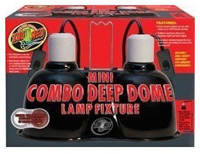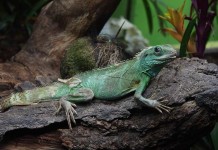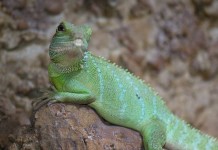Reptiles including Chinese water dragons have special light requirements that need to be fulfilled. Ideally, water dragons need 10 to 12 hours of exposure to full spectrum light. Sunlight without a doubt is the best light source for your pet. It has the perfect combination of UVA and UVB light that is required by water dragons.
Chinese water dragons belong to the tropical rain forests in Southeast Asia. They get good exposure to sunlight that stimulates the production of vitamin D and helps them absorb calcium. If you are unable to provide natural sunlight to your pet, it is important that you choose light sources that provide full spectrum lighting.
Most artificial sources of light including incandescent bulbs can only provide UVA light. This is not healthy for your pet. UVB light plays an important role in vitamin D production and absorption of dietary calcium. If the dragon enclosure lacks UVB light, it is less likely that your pet is able to absorb the calcium and vitamins you provide in the diet. The situation can have serious complications for your water dragon.
Reptiles that lack calcium tend to suffer from metabolic bone disease. This disease mainly is due to calcium deficiency but can be triggered by the lack of exposure to UVB light. To keep your pet healthy and disease free, you can install a UVB lamp directly over the basking area of your dragon’s enclosure. You should ensure that the lamp is not more than ten inches away from your dragon.
A UVB lamp that is more than ten to twelve inches from your dragon does not have the desired effect. You should take care that there is no glass or plastic between the lamp source and your pet. Glass blocks a large portion of the UVB rays which means your pet receives a negligible amount of the required light.
 Chinese water dragons are diurnal creatures. It means they remain active throughout the day and rest at night. Normally, water dragons don’t need a light source during the night. They prefer to relax and rest in dark to get recharged for the next day. It is recommended that you use “lightless” bulbs for the heating purpose at night.
Chinese water dragons are diurnal creatures. It means they remain active throughout the day and rest at night. Normally, water dragons don’t need a light source during the night. They prefer to relax and rest in dark to get recharged for the next day. It is recommended that you use “lightless” bulbs for the heating purpose at night.
You can time your light sources to turn on early in the morning and switch off at sunset. This will not only give your pet the required light but also maintain the required temperature.










